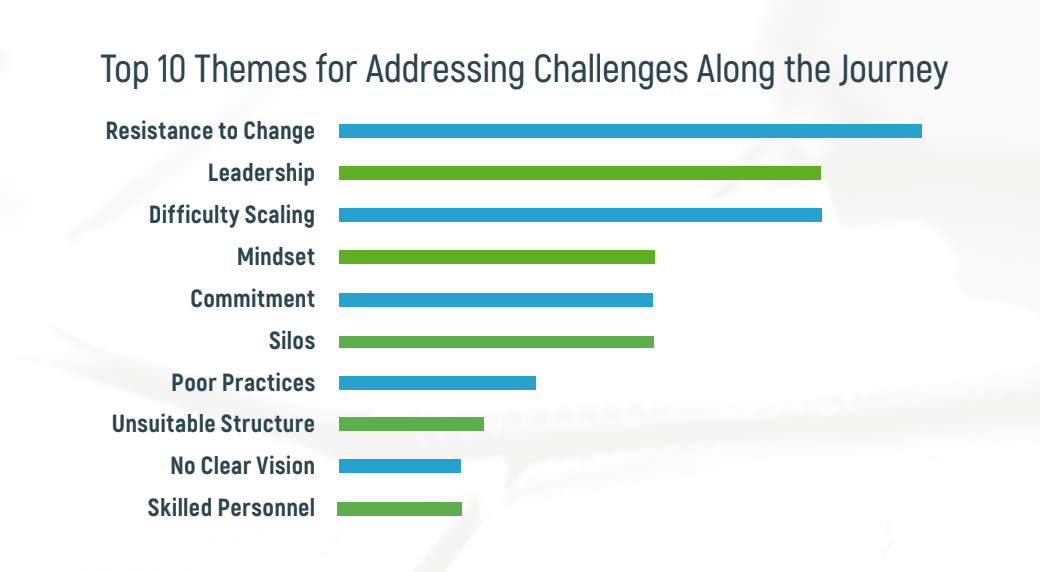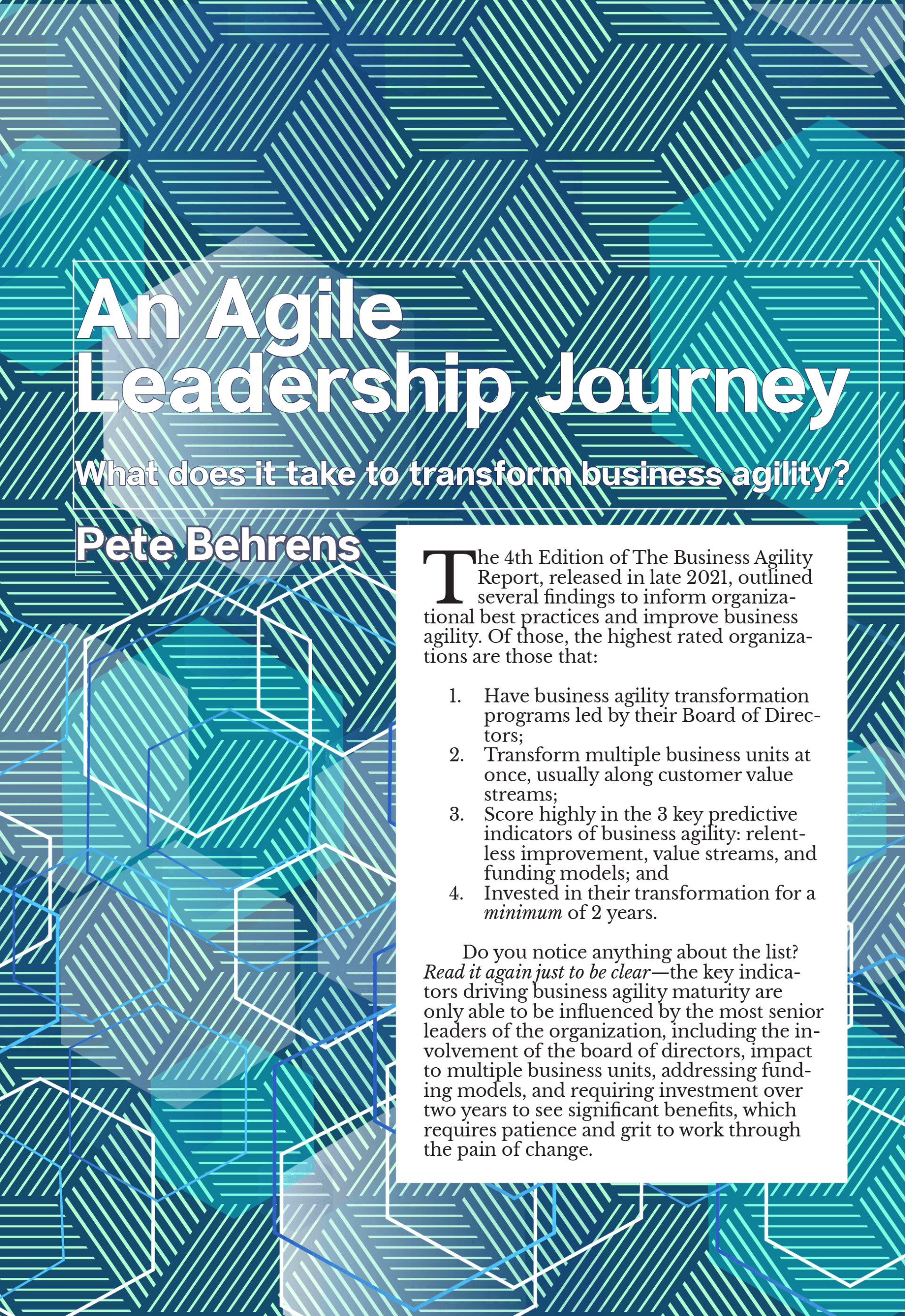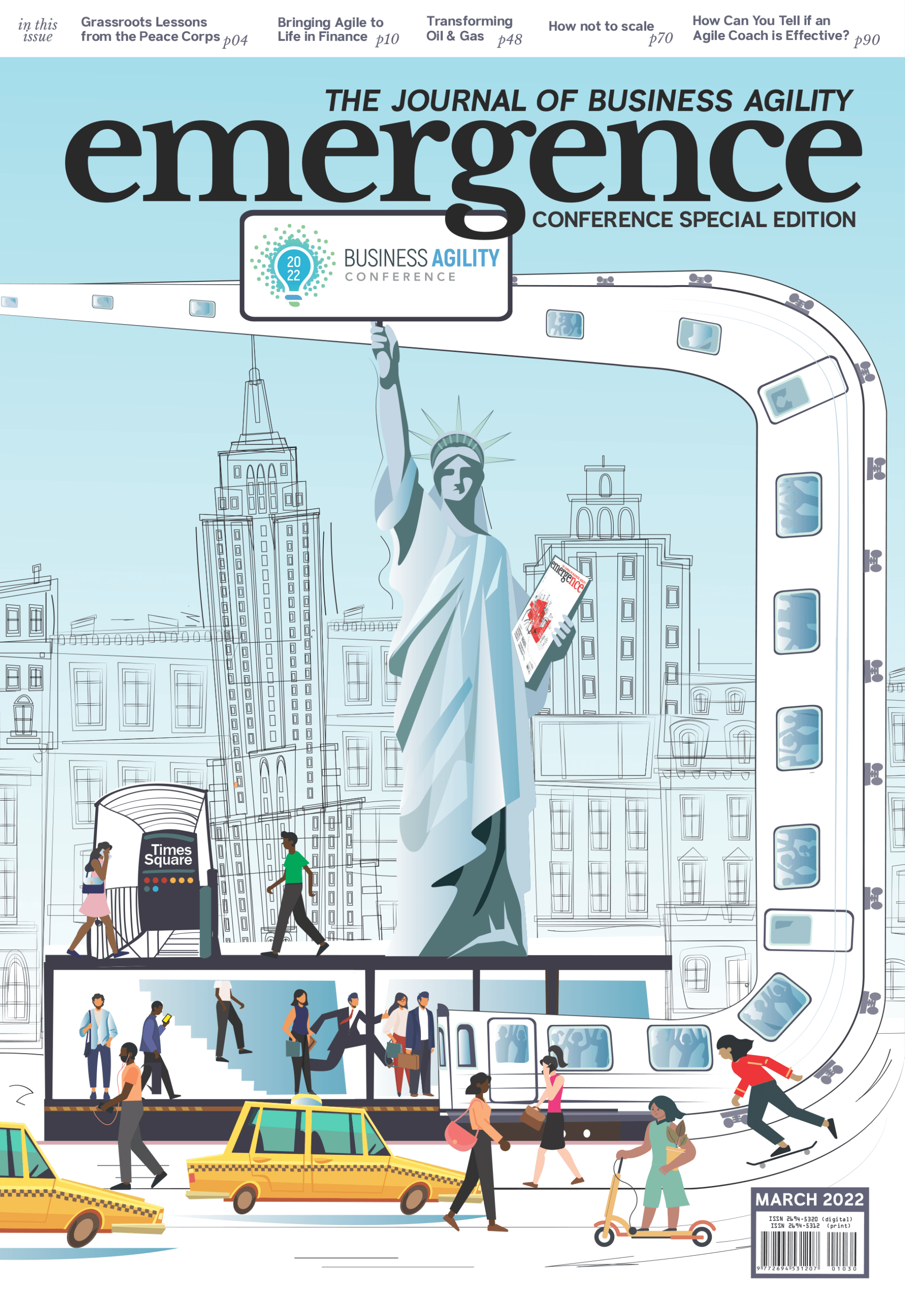An Agile Leadership Journey
What does it take to transform business agility?
The 4th Edition of The Business Agility Report, released in late 2021, outlined several findings to inform organizational best practices and improve business agility. Of those, the highest rated organizations are those that:
- Have business agility transformation programs led by their Board of Directors;
- Transform multiple business units at once, usually along customer value streams;
- Score highly in the 3 key predictive indicators of business agility: relentless improvement, value streams, and funding models;
- Invested in their transformation for a minimum of 2 years.
Do you notice anything about the list? Read it again just to be clear — the key indicators driving business agility maturity are only able to be influenced by the most senior leaders of the organization, including the involvement of the board of directors, impact to multiple business units, addressing funding models, and requiring investment over two years to see significant benefits, which requires patience and grit to work through the pain of change.
When we dig deeper into the report, we see key correlations between organizations and their aptitude toward business agility. The first of those correlations (and perhaps one of the least surprising) is that organization size plays a significant role in agility, with smaller organizations generally out-adapting their larger peers (although this is not a linear relationship). Larger organizations typically stratify leadership hierarchy deeper and depend further upon matrixed dependencies to accomplish shared goals. Larger organizations often rely more heavily on process controls and typically operate in more regulated industries that require such controls, including finance, healthcare, insurance, transportation, and government. But don’t let size deter you; organizations of all sizes are seeking and achieving increased business agility to improve their performance.
This leads us to our second observation: industry is a major influence on business agility. The top performing industries are Consulting (5.5 average maturity rating) and IT (5.1 average maturity rating) which have the fewest regulations. However, industry should not be considered a deterrent, but rather seen as a friction toward improved business agility and performance. It is a positive signal that the third and fourth highest industries on the maturity scale are Manufacturing, Automotive & Aerospace (4.8 average maturity rating) and Financial Services (4.7 average maturity rating), which do operate in a realm of higher regulatory oversight. Leaders need to move away from the binary thinking that their industry either will or will not allow business agility. Rather, leaders must adopt the mindset that business agility may look different and require more nuance and effort to achieve given the complexities different industries face, including regulatory requirements.
Likely the most interesting relationship is one of time. Companies are finding the need to continue their journeys toward improved business agility over many years. Companies on the journey for eight or more years demonstrate 50% more business agility (6.42 average maturity) than those with two years or less (4.12 average maturity). Let’s repeat that for emphasis — companies on the journey for eight or more years! The report indicates a first sign of improvement in two years with true impacts following much later.
For those who have been on the journey, this will not come as a surprise. For those I speak to each week considering a journey or newly on their own path toward improved business agility, this often comes as a shocking realization. Personally, I often pause to emphasize this point. In order for you, the leadership team, to accomplish what you are seeking, you need to commit to a multiyear focus which includes people, money, and time. The difference between a day hike and a month-long backpacking trip is significant. Leaders underprepared for this reality, thinking that this journey is a one-and-done this-year’s-leadership-initiative, are in for a reality check.
This leads us to our primary message: Leaders who do not transform themselves will have little impact in transforming business agility within their organizations. Why? Because changing organizational structures, processes and measures is only half the battle.
Think of organizational change like technology change. Improving technology comes in two forms: hardware upgrades and software upgrades. Both are required and co-dependent for improved features, functionality, usability, performance, etc. The same is true for organizational change for improved business agility. Hardware upgrades for organizations are represented by restructuring and reorganizing, mergers and acquisitions, and new tools and technologies. Software upgrades are represented by mindset and culture. Updating organizational structures, breaking down silos, and scaling more agile ways of working, are not enough. Updating personnel and leadership with a new mindset and culture are not enough. But combined, they can have a significant impact on business agility and performance.
Evidence that leaders must not only lead business agility transformation for their organizations, but indeed take an active role in transforming themselves, can be seen from the barriers identified in the report.

Once again, every barrier listed is related to leadership focus, beliefs and behaviors. While a few of the barriers relate to the organizational “hardware”—silos, unsuitable structures, and poor practices—a majority of the barriers more closely relate to the organizational “software”— resistance to change, leadership, mindset, commitment, and no clear vision. Whereas organizational hardware upgrades may be delegated to a change team or external consultancy, organizational software requires a more human connection and is directly related to the leadership mindset and behaviors.
Business agility requires leadership agility. So, what does it take to transform leadership?
Agile leadership is not a new concept and did not merely emerge from the technology-centric Agile movement of the last 20 years. In fact, adaptive leadership can be traced back to the beginnings of human development with surges of progress and roadblock setbacks along the journey. As technology has created workflow efficiencies, agile leadership developed from a need to be more adaptable in more complex scenarios. While the Agile movement formed at the turn of the century, the roots of agile leadership go much deeper.
Organizational leadership models today can be traced back to about 13,000 years ago. Around this time, agriculture enabled larger, formerly nomadic populations to form stable cities. As city populations grew, hierarchical leadership structures emerged to manage them. Leadership divisions formed around functions, and the connection between leaders and members—along with their power and status—slowly pulled apart. Land boundaries connected cities to form states and royal families ruling class-based societies emerged through this period of time.
The foundations of modern management, often attributed to Frederick Taylor and his consequential paper on The Principles of Scientific Management (1911), can be traced back to these earlier leadership principles. Taylor was incredible for his time in improving system workflow, irrespective of human impact. While he routinely improved manufacturing workflow by many multiples and improved quality and repeatability at the same time, he looked upon the workforce as incompetent, unskilled and not of value to train beyond simple repetitive tasks. Leaders think, workers do; Not far from the viewpoint of monarchical leaders ruling over their subjects.
Following World War II, Japanese manufacturing was struggling with quality control of its products. In a chance meeting and speech given by Edward Deming on Statistical Product Quality, Toyota and Deming began a relationship that likely inspired one of the most significant leadership shifts in our lifetimes and held Toyota’s position on top of the auto industry for the rest of the century. At the time labeled The Toyota Way, and now known as Lean Manufacturing, Deming and Toyota not only shook up the manufacturing process but fundamentally challenged the foundational leadership principles that ruled royal families and Taylorism. Deming put the line worker in charge of both their process and quality control, thus shifting the power of control from the manager to the worker. They installed an andon cord that ran the length of the line that any worker could pull to stop the entire process. Any worker stopping the plant triggered a deep dive (five whys) into the root cause of the problem before restarting.
Other companies attempted to copy Toyota’s new leadership model with little success. This wasn’t because Toyota hid their approach as a competitive advantage. Indeed, they gave tours and provided many other manufacturers with their playbook. It was the limitations of the other manufacturers who failed to recognize that installing the Toyota “hardware” structure and processes was not enough. It further required a “software” upgrade to change the mindset of leadership. Other companies were either unable, unwilling, or simply didn’t understand the new leadership principles that made the new processes work.
It wasn’t until the second half of the twentieth century that the leadership development community began to shake up the foundational theories and instilled practices reinforced by Taylor. Theory X & Y (1960), Servant Leadership (1970), Situational Leadership (1975), and Transforming Leadership (1978) were a few of the forerunners of a radical shift in thinking about leadership. Taking their lead from Toyota and Deming, these new researchers were proposing the leader serve the employee and that employee motivation should come from within rather than from the leader via external threats and incentives. This was not too different than Copernicus proposing the earth revolves around the sun—much of it falling on deaf ears.
However, concepts of adaptive leadership can be traced back to primitive times in human evolution. 2.5 million years ago, leaders and followers likely emerged through a reciprocity relationship that has been labeled service-for-prestige. Voluntary leader-follower relationships developed through the reciprocal exchange of demonstrated respect for valued services delivered (e.g. providing more food in exchange for hunting). Unlike the more hierarchical models, this reciprocal relationship had leaders more closely related to the work as direct service rather than overseeing others doing the work. Furthermore, the leaders more often emerged based on their experience rather than being instilled through lineage. Finally, these early leaders were more frequently challenged by their followers if they failed to provide services as opposed to later leaders who held the position regardless of results. In essence, followers had more status, relationship and autonomy with respect to their leader. Does this sound familiar? Essentially, Deming and the leadership models that followed are taking us back to our human roots rather than dramatically shifting away from them.
The reason this leader-follower relationship development is so critical is that for two millennia the human brain evolved to value this more dynamic, adaptive and reciprocal relationship. From our viewpoint in 2022, the past 13,000 years might feel like a very long time. However, from an evolutionary perspective, 13,000 years represents only 0.5% of the approximately 2.5 million years of human development! Our human desire for status, relationship and autonomy, along with the threat we feel when they are challenged or taken away, are deeply ingrained in all human DNA. The human brain codependency with status, certainty, autonomy, relatedness and fairness (SCARF) have been well documented through research by David Rock, author of Your Brain at Work and founder of the NeuroLeadership Institute.
Thus, we can see that through the lens of time, our last 13,000 years of leadership have been misguided. Businesses of today need to more closely resemble the nomadic nimbleness of our early human communities as compared to the stability and size of the later citystates. Larger organizations are finding that they are more adaptive and effective when operating as multiple smaller business units, each with the autonomy and relatedness to connect closely with their employees and customers. The leadership to drive these business units needs to be more connected, engaging, empowering, balanced, dynamic, and adaptive.
Agile leadership is not new. More adaptive leadership models have been reentering the workforce since the 1940’s when Deming and Toyota radically altered the power dynamics between leaders and workers. And yet, we are a long way from 1940. Today, the needs of business, and the leaders who lead them, need to change yet again. In the 1940s, leaders were seeking to optimize how to build a quality car in the most efficient manner. In the 2020s, leaders are seeking to innovate new ideas and technologies faster than competitors amidst rapid change and complexity that was inconceivable less than a hundred years earlier. While lean manufacturing processes and automation are dominant across the globe, lean leadership is more rare.
Today, the ability to effectively lead in a VUCA world is necessary at all levels of an organization. This is true regardless of whether you are leading an organization, a team, a project, or influencing in other ways. Leaders have the capacity to grow through multiple developmental stages to improve their effectiveness—what Bill Joiner and Stephen Josephs define as “leadership agility” in their book by the same name. As a leader develops agility, they increase their creativity to identify better outcomes, stakeholder engagement to co-create them, and the situational adaptiveness to achieve them. More agile leaders see more options, engage in more diverse dialogue, and make more informed decisions, resulting in the ability to take more effective actions and improve business agility. Leaders must combine real-time awareness with the openness and courage to situationally experiment on new approaches to everyday situations, thus developing new competencies. It not only depends on harnessing the leader’s strengths, but also in managing their emotional triggers and balancing dualities with no “right” answers.
Furthermore, how leaders think and approach their work and their employees shapes their organizational culture. That’s because how leaders think impacts their work—from what they focus on to how they measure success, from who they hire to how they compensate employees, from the policies and structures they develop to how they engage with others. How leaders think shapes what they do, and what they do shapes the organizational culture, which supports or impedes business agility.
The Agile Leadership Journey™ approach to leadership development and shaping culture is based on the belief (and the research that supports it) that leaders have the capacity to grow through stages to improve their effectiveness, that leadership can be developed, and that everyone, regardless of role or title, can demonstrate more effective leadership. We take the approach that leadership and culture have a symbiotic relationship—in other words, leadership shapes culture and culture shapes leadership. Leaders can develop the capacity to deliberately shape organizational culture to improve business agility, health, and performance. Effective leadership is a journey, not a destination.
This content was originally published in the March 2022 Conference Special Edition of Emergence, The Journal of Business Agility. It has been republished here with the permission of the publication.
What is Emergence?
Emergence is the Journal of Business Agility from the Business Agility Institute. Four times a year, they produce a curated selection of exclusive stories by great thinkers and practitioners from around the globe. These stories, research reports, and articles were selected to broaden your horizons and spark your creativity.








